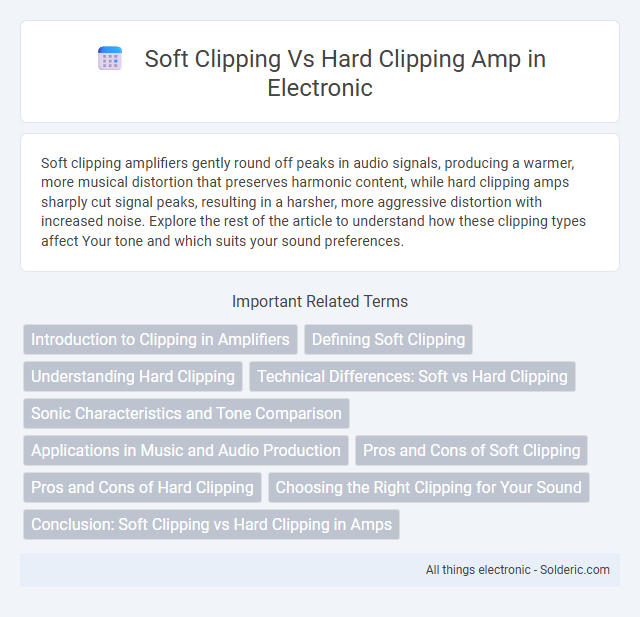Soft clipping amplifiers gently round off peaks in audio signals, producing a warmer, more musical distortion that preserves harmonic content, while hard clipping amps sharply cut signal peaks, resulting in a harsher, more aggressive distortion with increased noise. Explore the rest of the article to understand how these clipping types affect Your tone and which suits your sound preferences.
Comparison Table
| Feature | Soft Clipping | Hard Clipping |
|---|---|---|
| Clipping Type | Gradual waveform limiting | Abrupt waveform cutoff |
| Distortion Quality | Warm, smooth distortion | Harsh, aggressive distortion |
| Harmonic Content | Even and odd harmonics | Predominantly odd harmonics |
| Use Case | Guitar amps, tube emulation | High-gain amps, aggressive tones |
| Dynamic Response | Responsive, preserves dynamics | Compressed, reduced dynamics |
| Noise Level | Lower noise, smoother sound | Higher noise, potential harshness |
| Examples | Fender tube amps, vintage circuits | Modern high-gain amps, solid-state distortions |
Introduction to Clipping in Amplifiers
Clipping in amplifiers occurs when the input signal exceeds the amplifier's maximum output capacity, causing distortion by cutting off the peaks of the waveform. Soft clipping produces a smoother, more musical distortion by gradually compressing the signal, preserving harmonic content, while hard clipping abruptly cuts the waveform, generating harsher, more aggressive distortion with noticeable artifacting. Understanding the differences between soft and hard clipping helps You choose the right amp settings for desired tonal character and dynamic response.
Defining Soft Clipping
Soft clipping refers to a type of audio signal distortion where the waveform is gradually rounded off as it approaches the amplitude limit, resulting in a warmer and more musical overdrive effect. Unlike hard clipping, which abruptly cuts off the signal peaks causing harsher distortion and increased harmonic content, soft clipping preserves more of the natural dynamics and smooths out the signal peaks. This characteristic makes soft clipping popular in guitar amplifiers and audio processors aiming to maintain tonal richness while preventing harsh digital distortion.
Understanding Hard Clipping
Hard clipping occurs when an amplifier pushes audio signals beyond its maximum capacity, causing waveform peaks to be abruptly cut off, resulting in a distorted and aggressive sound. This form of clipping generates high-frequency harmonics that can introduce harshness and potential speaker damage if sustained at high levels. Musicians and audio engineers often use hard clipping deliberately for its raw, gritty tonal characteristics, especially in genres like rock and metal.
Technical Differences: Soft vs Hard Clipping
Soft clipping gently rounds off audio signal peaks, preserving harmonic content and producing a warmer, less distorted sound by gradually compressing the waveform near the threshold. Hard clipping abruptly truncates signal peaks once they exceed a set threshold, creating sharp cutoffs that introduce significant harmonic distortion and a harsher, more aggressive tone. This technical difference in waveform processing impacts the perceived audio quality and is crucial in amplifier design for achieving desired tonal characteristics.
Sonic Characteristics and Tone Comparison
Soft clipping amplifiers produce a warm, smooth distortion by gradually compressing signal peaks, enhancing harmonic richness and maintaining more musical overtones. Hard clipping amps create a harsher, more aggressive tone with sharp, abrupt signal cutoffs that generate higher-order harmonics and more pronounced distortion artifacts. Soft clipping tends to preserve dynamic response and articulation, while hard clipping delivers intense saturation favored in heavier rock and metal genres.
Applications in Music and Audio Production
Soft clipping amplifiers create smooth, rounded waveforms that add warmth and harmonic richness, making them ideal for guitar distortion and vocal effects in music production. Hard clipping amps produce sharp, aggressive waveforms that generate pronounced distortion and sustain, commonly used in heavy metal and punk genres for intense guitar tones. Audio engineers choose soft clipping for subtle saturation and dynamic control, while hard clipping is preferred for bold, cutting sounds that stand out in dense mixes.
Pros and Cons of Soft Clipping
Soft clipping amps produce smoother distortion by gradually limiting signal peaks, preserving more natural-sounding harmonics and reducing harshness, which makes your tone warmer and more musical. However, soft clipping can result in less aggressive gain and may not provide the intense saturation or dynamic edge that hard clipping delivers for heavier styles. Its pros include enhanced tonal warmth and reduced digital-like harshness, while cons involve limited output volume and a softer overall distortion character.
Pros and Cons of Hard Clipping
Hard clipping amps produce a distinct, aggressive distortion by sharply cutting off audio peaks, enhancing guitar tones with intense saturation and sustain. The main advantages include a powerful, crunchy sound favored for heavy music genres and increased loudness without complex circuitry. However, hard clipping can introduce harsh, unpleasant distortion and audible unwanted noise, potentially causing speaker damage and reducing audio fidelity compared to softer clipping methods.
Choosing the Right Clipping for Your Sound
Soft clipping amps create smooth distortion by gradually compressing the waveform, preserving warmth and musicality, ideal for blues and jazz tones. Hard clipping amps sharply cut the waveform peaks, producing aggressive, edgy distortion favored in metal and punk genres. Choosing the right clipping for your sound depends on whether you want a warm, organic overdrive or a harsh, saturated distortion to define your tone.
Conclusion: Soft Clipping vs Hard Clipping in Amps
Soft clipping amps produce smoother, warmer distortion by gradually rounding wave peaks, preserving harmonic content and minimizing harshness. Hard clipping amps cut wave peaks abruptly, resulting in more aggressive, buzzy distortion that enhances sustain but can cause ear fatigue over time. Your choice between soft and hard clipping depends on the desired tonal character and playing style, with soft clipping favored for classic warmth and hard clipping preferred for high-gain, aggressive sounds.
Soft clipping vs Hard clipping amp Infographic

 solderic.com
solderic.com